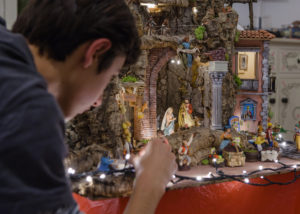While Americans celebrate the holidays by displaying decorated Christmas trees in their homes, Italians remain true to the essence of Christmas by displaying a Presepio (Nativity scene) in their homes and churches to celebrate the birth of Christ.
Origin: The Presepio was first created in 1223, by St. Francis of Assisi, in a cave outside the Italian town of Greccio. St. Francis placed a manger in the cave with live animals so the townspeople could recreate the birth of Jesus prior to the celebrations of Christmas Eve mass.
The carving of the figures for the Presepio began in the 13th century when Arnolfo di Cambio was commissioned by Pope Boniface VIII to sculpt marble figures that would be presented at the first Rome Jubilee. This event inspired the nobility to begin displaying elaborate Presepio scenes in their homes. Soon thereafter, the common people followed suit.
Hence a tradition was born that has been recreated in all of Italy’s churches and homes for nearly 800 years.
Characters represented: The figures of Baby Jesus, Mary and Joseph are displayed in a manger; however the figure of Christ is not placed in the crib until Christmas Eve. Other figures include the shepherds and various farm animals, angels, peasants either playing instruments or presenting gifts of bread, as well as some Roman soldiers, who are far removed from the manger.
The Three Kings, bearing their gifts of gold, frankincense and myrrh, are often added to the Presepio a few days after Christmas to represent the time it took them to travel to Bethlehem.
Dates for displaying the Presepio: The Presepio is usually displayed from Dec. 8, the Feast Day of the Immaculate Conception, to Jan. 6, the Feast Day of the Epiphany, in Italian homes and churches. Presepio are also often displayed in piazzas, shops and other public areas. Varying in size from small manger settings to elaborate town settings, the figures also vary in scale from miniature to life size.
Both the churches and the people take great pride in the beauty of the Presepio that they craft and create.
The heart of Presepio crafting: There’s just one place to purchase the finest figurines and scene — Naples. Naples has an entire street, Via San Gregorio Armeno, in Spaccanapoli (the city’s historic section) where store after store is filled with handmade mangers, villages and figurines.
The Presepio is yet another beautiful example of how Italians, over the centuries, have utilized their great artistry and creativity to express their adoration and devotion for their Catholic faith.





